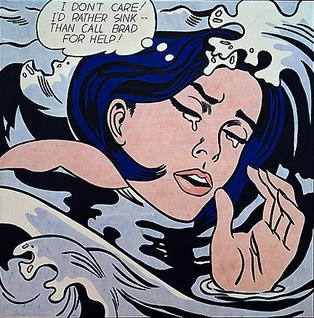
Roy Lichtenstein was one of the first American Pop artists to attain global acclaim, and he became a potent symbol for the movement’s critics. His early work was diverse in style and subject matter, demonstrating a thorough mastery of modernist painting. Lichtenstein would frequently assert that he was equally interested in the abstract elements of his paintings as he was in their subject matter. However, the mature Pop style he achieved in 1961, inspired by comic strips, was met with allegations of dullness, lack of originality, and, later, imitation. His high-impact, iconic images have since become synonymous with Pop art, and his process of making images, which combined features of machine replication with hand drawing, has been crucial to critics’ assessment of the movement’s significance.

Throughout the twentieth century, art had held references to popular culture, but in Lichtenstein’s works, the styles, subject matter, and reproduction processes prevalent in popular culture appeared to dominate the art altogether. This was a significant departure from Abstract Expressionism, whose frequently melancholy subjects were considered to spring up from the painters’ souls. Lichtenstein’s inspirations came from culture as a whole and reflected nothing of the artist’s feelings.
Although Lichtenstein was frequently accused of simply copying his graphics from cartoons in the early 1960s, his process entailed significant reworking of the source images. The magnitude of those modifications, and the artist’s rationale for adding them, have long been key to debates of his work. They appear to show whether he was more concerned in making appealing, aesthetic compositions or startling his viewers with the blatant impact of popular culture.

One of the central lessons of Pop art is that all forms of communication, all messages, are filtered through codes or languages. Lichtenstein’s emphasis on mechanical reproduction methods – particularly his signature use of Ben-Day dots – highlighted one of the central lessons of Pop art: that all forms of communication, all messages, are filtered through codes or languages. His early work, which drew on an eclectic variety of modern art, is thought to have taught him the value of codes. This admiration may have eventually led him to create work influenced by modern art masterpieces. In these works, he asserted that high art and popular art are alike in that they both rely on code.

His artwork, Drowning Girl, contains numerous examples of powerful, dark lines, the majority of which are curved rather than straight. Benday dots aid in the creation of shadows in the artwork; without them, the picture appears flat and two-dimensional. The swirling lines that define the velocity of the water provide depth to the painting and increase the overall space. As the picture appears to be a spiral, there is no distinct vanishing point. The placement of the subject matter near the middle of the piece makes it slightly simpler for the viewer’s eye to be drawn to the emotion on her face. The swirling lines employed in the artwork create a minor recurrence, as does the motion of the water. These give off a sense of uncertainty, which creates a tiny sensation of chaos and confusion. However, there is also a sensation of calm because the water appears to be moving rather gently. There is not much contrast between the colours. Instead, Lichtenstein’s artwork consists primarily of varied colours of blue. This is a tonal gradient, which helps to emphasize the artwork’s detail.
Sources:
https://en.wikipedia.org/wiki/Roy_Lichtenstein
https://www.britannica.com/biography/Roy-Lichtenstein
Image Sources:
https://feltmagnet.com/painting/The-Prophetic-Paintings-of-Roy-Lichtenstein

December 16, 2021 at 8:00 pm
Garleen,
Nice intelligent work on Lichtenstein here! Your information is solid and thorough and your analysis is excellent. I’m giving you a 2/2 for your final post here! Also your score on the final quiz was 21/50. Enjoy your holiday break.
Jeff